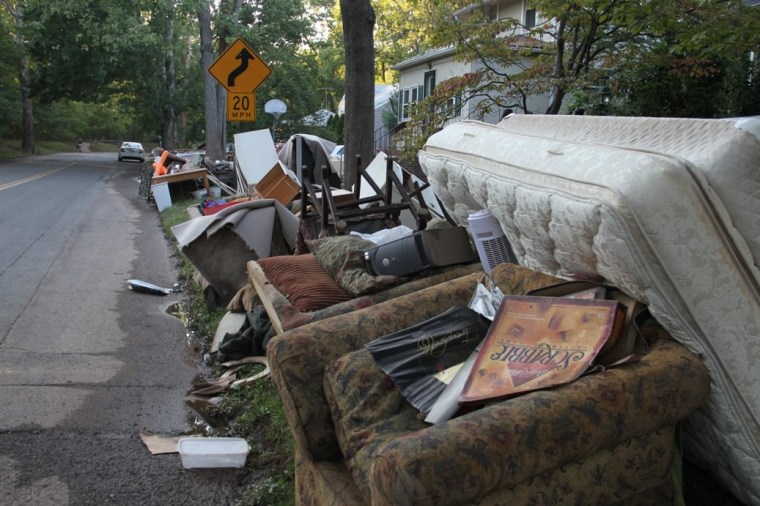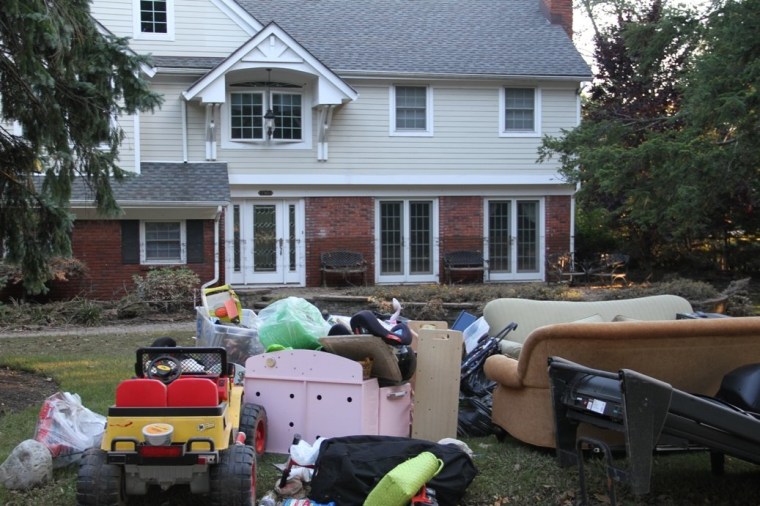
CRANFORD, N.J. -- Picking up the pieces sometimes means throwing out everything you own.
Hurricane Irene caused historic flooding in some New Jersey communities, none hit harder than Cranford, N.J., about 20 miles west of New York City. About one-fifth of the homes in this middle-class suburb were hit by devastating overflow when the Rahway River breached containment. After the waters receded, thousands of residents were stuck with the onerous task of carting most of their belongings out to the curb and placing them in neat piles in the front yard for eventual disposal. On Tuesday afternoon, the north side of Cranford looked like an eerie yard sale was taking place.
If you walked into Cranford on a nice summer day -- like Tuesday -- you'd see a picture-perfect, leafy New York suburb with a thriving downtown and charming Victorian homes. The path around the duck pond at Nomahegan Park might persuade you to take up jogging. The Rahway River winds lazily through town, looking like not much more than a babbling creek. Hugged by Riverside Drive, the berm beside it doubles as an inviting bike trail.
The town isn't just masquerading as a perfect American hamlet; it has some credentials. The name comes from a place in town once called Crane's Ford -- a spot where Revolutionary soldiers set up an outpost to defend Gen. George Washington's Morristown headquarters.
At first glance, nothing seemed wrong in Cranford on Tuesday. There were virtually no downed trees -- hardly any scattered branches or leaves. And there was no standing water, or even any large puddles, to suggest that the Rahway River had ravaged the town just 48 hours earlier.
But on the north side of town, it looked like a crazy community yard sale was under way. Mountains of personal belongings, neatly piled 4 or 5 feet high, crowded sidewalk after sidewalk. The piles contained decades worth of belongings, entire family histories, ruined by a massive flood caused by Hurricane Irene.
Cranford, about a 45-minute train ride from midtown Manhattan, is one of the New Jersey towns hit hardest by post-Irene flooding, so I went to see the damage myself. I covered Cranford Township as a cub reporter in the early 1990s for the Cranford Chronicle, so I knew the spots in town most prone to flooding. But my inside knowledge wasn't necessary. Cranford's gleaming city hall and police complex, which stands at the entrance to town, was ruined by the flood. The front lawn currently serves as police headquarters. About 10 officers milled about there on Tuesday, along with Mayor Dan Aschenbach. He said it would cost about $1 million to fix the building. Then he urged me to follow the trail taken earlier that day by Sen. Frank Lautenberg, D-N.J., who came to inspect the damage to homes near Riverside Drive.
"Where should I go?" I asked.
"Anywhere," the mayor said. "It won't be hard to find."
I hopped on my bike, which often makes navigating around storm-stricken neighborhoods a little easier. It wasn't necessary, however. Cranford's roads were fine. There were no obstacles to navigate -- just piles and piles of stuff on the sidewalks that you’d expect to find in a basement: baby toys, couches, refrigerators, barely-used exercise equipment, stereo turntables, cassette players, and boxes and boxes of papers.

Irene struck like a smart bomb. It left nature pretty much intact; it merely destroyed people's lives. According to Aschenbach, about one-fifth of the town's 8,000 homes were damaged by flooding. The piles of stuff went on for as far as I could bike.
The only other signs that something horrible had happened here were the pungent odor of gasoline and the whirring noise of generators -- the town is still without power -- and the long faces on the people quietly shuttling in and out of their homes with wheelbarrows full of personal belongings.
I hate interrupting people at times like this, but it's my job. The first man I tried to talk with politely declined, saying he "just had too much to do." Daylight hours are precious for hurricane cleanups when the power is still out.
Down the road, I came upon a family of four struggling to carry a soaking wet sofa bed to the curb. Their home was on Riverside Drive, with only a berm of 10-feet or so between it and the river. Now, the yard was jammed with more belongings than most. Their white picket fence was being used as a clothes line, jammed with sweaters, T-shirts and jeans. Dressers, couches, a treadmill -- all caked in mud -- lay at the end of their driveway.
When I asked if I could interrupt, two older adults scurried off, but two younger women said they'd oblige. Giselle and Zenayda Sedano, sisters in their 20s, said they'd bought the home in October 2009.

"It was our dream," said Zenayda, the older sister. "We did it to keep the family together, so our mom and dad could have a nice place to live. Now, we have nothing. Everything we owned has been ruined."
They gave me a tour of the house, which had been flooded clear up to the second floor. The cleanup was pure drudgery, as they found memento after memento that can't be restored and was destined for the pile of broken memories in the front yard. It was also disgusting – “all the dirt, mud, feces, whatever is in that river was in our house,” said Giselle –adding that she'd changed clothes four times during the day. Still, the emptier the house, the better chance for it to dry, and the better chance mold won't take hold.
At that point, she looked at her hands and sighed.
“My manicure looks awful,” she said.
Before Sunday, Zenayda and Giselle were living the American dream. Giselle works as a hedge fund analyst in New York City, and graduated from Cornell in 2008. Her sister works in the pharmaceutical business and graduated from Rutgers.
“When my parents came to this country from Peru in their 20s, all they had was what they could fit in a suitcase,” Giselle said. “Now, all we have is what we could fit in the suitcase we took with us before the storm.”
Their mom used to keep the modest three-bedroom home impeccably clean, sweeping the floor every day. Now mud is caked on everything they own. Water and leaves were in their prized China closet, where most of the China had been smashed.
Their mother was washing her mud-caked LP records, brought from Peru in the 1980s. Giselle didn’t have the heart to tell her they won’t make music any more.
“I keep telling her, ‘It’s OK. They’ll play,'” she said.
When the family evacuated to a nearby hotel where their mom works on Saturday nights, they placed important objects on tables or atop cabinets. They assumed some flooding might occur, but had no idea the flooding could reach so high. Neither did Cranford officials, who eventually ordered everyone within a 500-year flood zone to evacuate. That meant experts expected the flooding to reach levels attained only once every 500 years.
The odds were against such damage; still, the Sedanos weren't unprepared -- they had purchased flood insurance. That will eventually pay for repairs to the home, but won’t replace the contents. Many of them, like Giselle’s college diploma, would be irreplaceable anyway.
"When we first came home we just broke down and cried,” Giselle said. “Every two seconds we have to hug each other and hold each other and keep saying ‘we're alive, we've alive,’ but it hurts.”